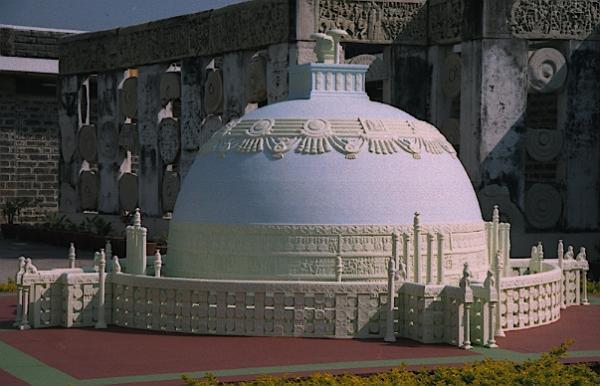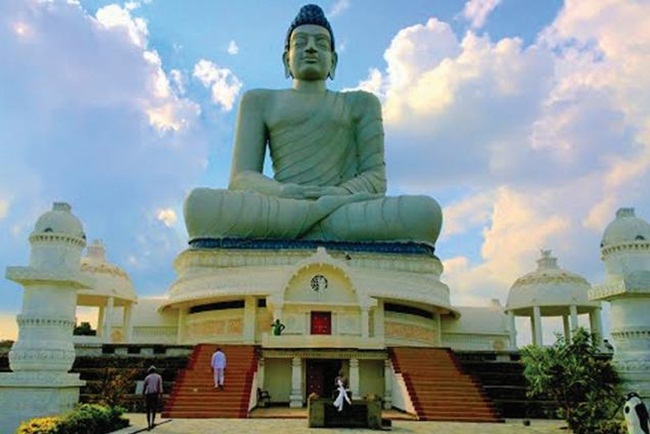The foundation stone of the new capital of Andhra Pradesh was ceremoniously laid by Prime Minister Narendra Modi yesterday. The new capital city Amaravati is being referred to as people’s capital because soil and water from 16,000 villages in the state, prominent seats of pilgrimage from across the country, and some foreign countries were used for the foundation ceremony, attended by around 4 lakh people. Spread over 54,000 acres between Vijayawada and Guntur, Amaravati is easily accessible because of its central location. The upcoming capital of Andhra Pradesh holds lots of economic, geographic, cultural and historic value.
The History of Amaravati
The history of Amaravati or Amaravathi dates from the 2nd century BC. If the 2000-year old history is believed, it was a thriving capital of the Satvahana Kingdom in ancient India just as Patliputra (modern-day Patna) was the capital of Magadh during the Maurya era. The rulers of the Satvahana dynasty were in power from 3rd century BC to 2nd CE between the Maurya and Gupta eras, which are considered golden times of India. Evidently, Amaravati has rich history for being the yesteryear capital city of the Satvahana Empire.
The history of Amaravathi continued till the fall of Nizams in the princely state of Hyderabad. After the fall of the Satvahana Kingdom, the Pallava Dynasty annexed the Krishna River valley where Amravati is located. Then the region was ruled by the Chalukyas and the Cholas subsequently till Amaravati was made part of the Telugu Empire by the Kakatiyas in the medieval times.
The rulers of several dynasties added to the history of Amaravati from the medieval times of India till the end of the Mughal era. The Delhi Sultanate, the Bahmani Sultanate, the Golconda Sultanate, the Vijayanagar Empire, and the Mughal Empire possessed Amaravathi successively till the first Nizam of Hyderabad occupied it. Even Hyder Ali of Mysore possessed it for a brief period. Amravati was colonized by the French in 1750 and by the British in 1759, too.
Among the foreign pilgrims to ancient India, Chinese traveler and Buddhist monk Hiuen Tsang visited Amaravati in 640 CE.
The Culture of Amaravati
Being part of several different dynasties over centuries, Amaravathi has a miscellaneous culture which is rich and diverse. It used to have great cultural impact on the people of Madhya Pradesh, Gujarat, Maharashtra, Karnataka and Andhra during the post-Mauryan period. The Satvahana rulers preserved Hinduism and patronized Buddhism with equal care. It enriched the culture of Amaravati with enlightenment and rationality.
Many historical facts bear a testimony to the Buddhist influence on the culture of Amravati in the bygone years. The valley between the Krishna and the Godavari River had been a prominent site of Buddhism since before the Satvahana rose to power. A stupa and a monastery were built when Ashoka was the king of the Mauryan Empire in the 2nd century BCE. It is said that the stupa at Amravati, measuring 50 meters in diameter and 27 meters in height, was one of the biggest Buddhist stupas in Andhra Pradesh. The panels carved on it depict the story of Lord Buddha.
Amaravati is known for its own school of architecture influenced by the Buddhist art and culture. The Amravati school of architecture has unique features, which is evident from the sculptural work on the Buddhist monastery of Amaravathi.
According to art historians and art critics, the Amaravati art is among the major three ancient schools of Indian art. Many works of the Amravati art are preserved at the Government Museum in Chennai and the British Museum in London. The Southeast Asian arts including the art of Sri Lanka are found to be influenced by it.
The Religious Value of Amaravati
According to some sources related to ‘Vajrayana Buddhism’, Lord Buddha himself visited Dharanikota, a place adjacent to Amaravathi, and preached there. If this legend is believed, the history of Amaravati dates back to the 500 BCE. After the Emperor Ashoka, the Satvahana rulers contributed to the development of Buddhist culture by building imposing stupas in the Krishna River valley.
The famous Amaravati Stupa is said to have been built in presence of presence of the great saint, Acharya Nagarjuna. Besides, Amaravathi is home to some Buddhist relics dating 2000 years back. Evidently, the upcoming capital of Andhra Pradesh is an important pilgrimage site for Buddhists.
Amaravati is a seat of pilgrimage for not only Buddhists but also Hindus. It is home to several Lord Shiva temples, of which the most famous is Lord Amaralingeswara or Amareswara Swamy Temple. That is why the new capital of Andhra Pradesh is also known as Amararamam.
Of the legends of Amaravati, one says that when the demon Tarakasura was killed, a shivalingam in his throat broke into pieces which fell out of his mouth in five different spots. The most significant of the five spots is Amareswara at Amaravati, and this is the place where Indra and the other gods are said to have worshiped Lord Shiva.
Jainism used to coexist with Buddhism and Hinduism in Amaravathi during the bygone eras following the decline of the Satvahana Dynasty. Therefore, Amaravati is also known as ‘City of Tolerance’ or Sridhanyakataka. Being a center of pilgrimage for Hindus and Buddhism, Amaravati is also known as ‘Punyakshetra’ (holy land).




